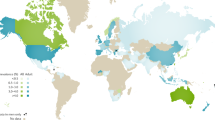Abstract
Gout affects over 1% of the world’s adult population and, furthermore, gout is the form of inflammatory arthritis most prevalent in men. Gout incidence rates are now on the rise due to aging-associated effects depending on quality of life, and comorbid conditions, and the efficiency of their management. Gout is traditionally considered a disease affecting men, although, in fact, women prevail among elderly patients. The growth trends in gout incidence throughout the world point to the necessity of developing novel diagnostic markers.
Similar content being viewed by others
References
Abdelrahman, M., Rafi, A., Ghacha, R., et al., Hyperuricemia and gout in renal transplant recipients, Renal Failure, 2002, vol. 24, pp. 361–367.
Arromdee, E., Michet, C., Crowson, C., et al., Epidemiology of gout: is the incidence rising?, J. Rheumatol., 2002, vol. 29, pp. 2403–2406.
August, P., Initial treatment of hypertension, N. Engl. J. Med., 2003, vol. 348, pp. 610–617.
Bardin, T. and Richette, P., The epidemiology and genetic of gout, Presse Med., 2011, vol. 40, pp. 830–835.
Baroletti, S., Bencivenga, G.A., and Gabardi, S., Treating gout in kidney transplant recipients, Progr. Transplant., 2004, vol. 14, pp. 143–147.
Bieber, J. and Terkeltaub, R., On the brink of novel therapeutic options for an ancient disease, Arthritis Rheum., 2004, vol. 50, pp. 2400–2414.
Caspi, D., Lubart, E., Graff, E., et al., The effect of mini-dose aspirin on renal function and uric acid handling in elderly patients, Arthritis Rheum., 2000, vol. 43, pp. 103–108.
Chen, H.S., Clinical implications of the metabolic syndrome and hyperuricemia, J. Chin. Med. Assoc., 2011, vol. 74, no. 12, pp. 527–528.
Choi, H.K., Diet, alcohol, and gout: how do we advise patients given recent developments, Curr. Rheumatol. Rep., 2005, vol. 7, pp. 220–226.
Choi, H., and Curhan, G., Beer, liquor, and wine consumption and serum uric acid level: The third national health and nutrition examination survey, Arthritis Rheum., 2004, vol. 51, pp. 1023–1029.
Choi, H.K. and Curhan, G., Dairy consumption and risk of incident gout in women: the nurses health study, Arthritis Rheum., 2005, vol. 52, suppl. 9, pp. S31–S41.
Choi, H., Atkinson, K., Karlson, E., and Curhan, G., Obesity, weight change, hypertension, diuretic use, and risk of gout in men, Arch. Intern. Med., 2005, vol. 165, pp. 742–748.
Choi, H., Atkinson, K., Karlson, E., et al., Alcohol intake and risk of incident gout in men: a prospective study, Lancet, 2004, vol. 363, pp. 1277–1281.
Choi, H., Atkinson, K., Karlson, E., et al., Purine-rich foods, dairy and protein intake, and the risk of gout in men, N. Engl. J. Med., 2004, vol. 350, pp. 1093–1103.
Culleton, B.F., Larson, M.G., Kannel, W.B., and Levy, D., Serum uric acid and risk for cardiovascular disease and death: the Framingham heart study, Ann. Intern. Med., 1999, vol. 131, pp. 7–13.
Dessein, P., Shipton, E., Stanwix, A., et al., Beneficial effects of weight loss associated with moderate calorie/carbohydrate restriction, and increased proportional intake of protein and unsaturated fat on serum urate and lipoprotein levels in gout: a pilot study, Ann. Rheum. Dis., 2000, vol. 59, pp. 539–543.
Fang, J. and Alderman, M., Serum uric acid and cardiovascular mortality: NHANES I epidemiologic follow-up study, 1971–1992, JAMA, J. Am. Med. Assoc., 2000, vol. 283, pp. 2404–2410.
Ford, E.S., Giles, W.H., and Dietz, W.H., Prevalence of the metabolic syndrome among U.S. adults. Findings from the Third National Health and Nutrition Examination Survey, JAMA, J. Am. Med. Assoc., 2002, vol. 287, pp. 356–359.
Hollander, A.A., van Saase, J.L., Kootte, A.M., et al., Beneficial effects of conversion from cyclosporin to azathioprine after kidney transplantation, Lancet, 1995, vol. 345, pp. 610–614.
Huang, H.Y., Appel, L.J., Choi, M.J., et al., The effects of vitamin C supplementation on serum concentrations of uric acid: Results of a randomized, controlled trial, Arthritis Rheum., 2005, vol. 52, pp. 1843–1847.
Ichikawa, N., Taniguchi, A., Urano, W., et al., Comorbidities in patients with gout, Nucleosides, Nucleotides Nucleic Acids, 2011, vol. 30, no. 12, pp. 1045–1050.
Johnson, R.J., Segal, M.S., Srinivas, T., et al., Essential hypertension, progressive renal disease, and uric acid: a pathogenetic link?, J. Am. Soc. Nephrol., 2005, vol. 16, pp. 1909–1919.
Kim, C. and Beckles, G.L., Cardiovascular disease risk reduction in the behavioral risk factor surveillance system, Am. J. Prev. Med., 2004, vol. 27, pp. 1–7.
Kim, K.Y., Schumacher, H.R., Hunsche, E., et al., A literature review of the epidemiology and treatment of acute gout, Clin. Ther., 2003, vol. 25, pp. 1593–1617.
Meigs, J.B., Wilson, P.W., Nathan, D.M., et al., Prevalence and characteristics of the metabolic syndrome in the San Antonio heart and Framingham offspring studies, Diabetes, 2003, vol. 52, pp. 2160–2167.
Mikuls, T., Farrar, J., Bilker, W., et al., Suboptimal physician adherence to quality indicators for the management of gout and asymptomatic hyperuricaemia: Results from the UK General Practice Research Database (GPRD), Rheumatology, 2005, vol. 44, pp. 1038–1042.
Sanchez-Lozada, L.G., Tapia, E., Avila-Casado, C., et al., Mild hyperuricemia induces glomerular hypertension in normal rats, Am. J. Physiol. Renal. Physiol., 2002, vol. 283, pp. 1105–1110.
Willett, W.C. and Stampfer, M.J., Rebuilding the food pyramid, Sci. Am., 2003, vol. 288, pp. 64–71.
Author information
Authors and Affiliations
Corresponding author
Additional information
Original Russian Text © A.L. Ariev, N.A. Kunitskaya, L.S. Kozina, 2012, published in Uspekhi Gerontologii, 2012, Vol. 25, No. 3, pp. 540–544.
Rights and permissions
About this article
Cite this article
Ariev, A.L., Kunitskaya, N.A. & Kozina, L.S. New data on gout and hyperuricemia: Incidence rates, risk factors and aging-associated manifestations. Adv Gerontol 3, 138–141 (2013). https://doi.org/10.1134/S2079057013020021
Published:
Issue Date:
DOI: https://doi.org/10.1134/S2079057013020021



